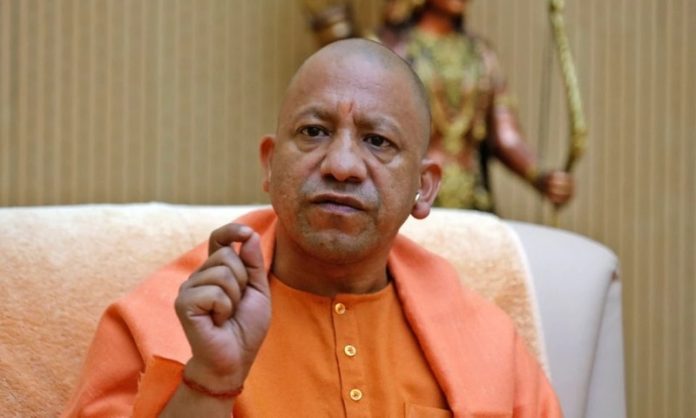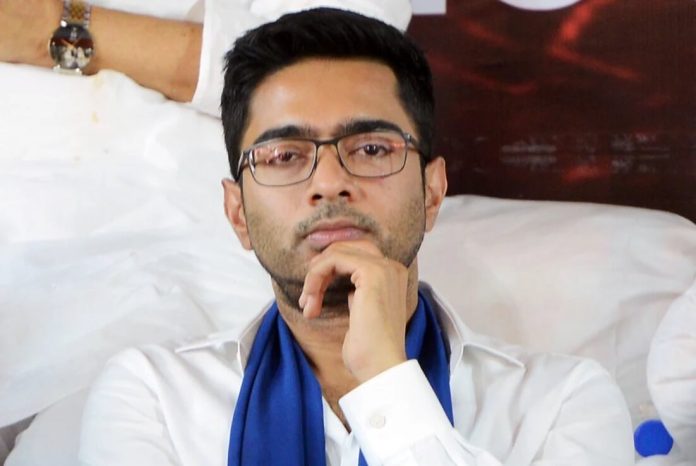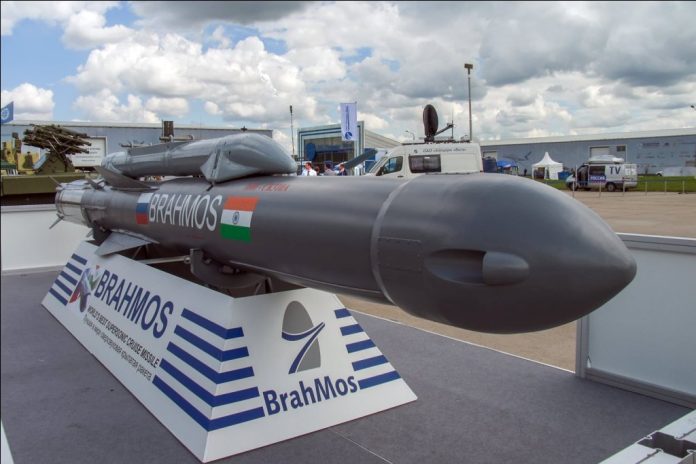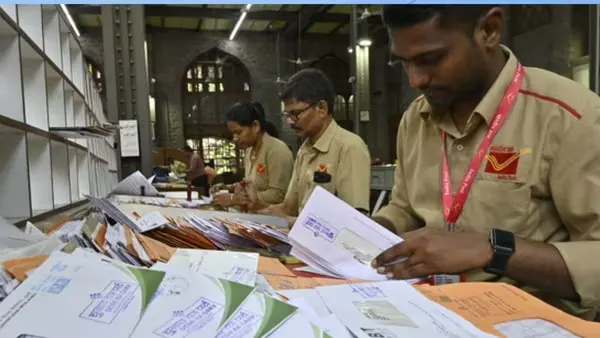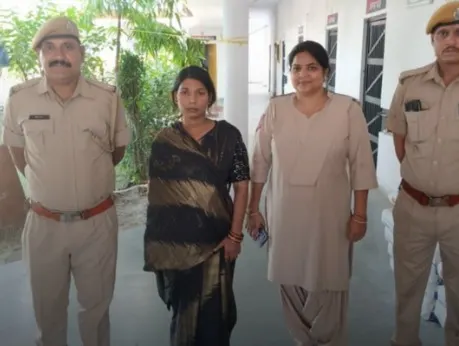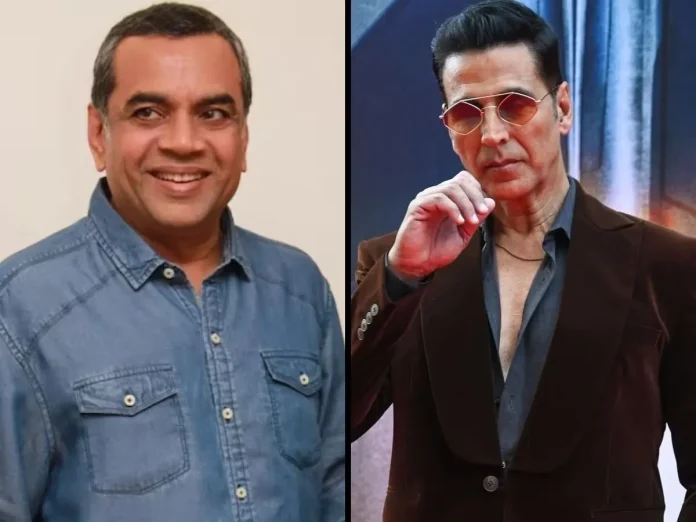War 2 Hrithik Roshan Teaser Out: ट्रेन की छत से प्लेन तक, ऋतिक vs NTR की जंग ने उड़ाए होश
War 2 Hrithik Roshan Teaser Out: बॉलीवुड (Bollywood) की सबसे बड़ी स्पाई यूनिवर्स YRF में अब तक की सबसे बड़ी टक्कर देखने को मिलने वाली है। ‘वॉर 2’ का टीज़र मंगलवार सुबह रिलीज हुआ, और रिलीज़ होते ही सोशल मीडिया पर धमाका कर गया। ये टीज़र खास तौर पर जूनियर एनटीआर के जन्मदिन (Happy BirthDay Junior NTR) के मौके पर लॉन्च किया गया, जिसमें वो पहली बार ऋतिक रोशन के सामने एक्शन मोड में दिखे। ऋतिक एक बार फिर अपने फेमस किरदार ‘कबीर’ के रूप में लौटे हैं और इस बार उनका मुकाबला साउथ के पावर हाउस एनटीआर से है।
Hrithik Roshan और Junior NTR के बीच जंग देख क्या बोले फैंस
टीजर में दिखा दोनों का खतरनाक फेस-ऑफ, जिसमें कभी प्लेन की छत तो कभी तेज रफ्तार ट्रेन पर लड़ाई हो रही है। फैंस ने इसे देख कर लिखा, “ये तो आरआरआर और पठान से भी बड़ा ब्लॉकबस्टर आने वाला है। एक यूजर ने कहा, “ऋतिक वापस कबीर स्टाइल में आ गए हैं, अब तो काउंटडाउन शुरू।”
सिनेमाघरों में इस दिन रिलीज होगी War 2
जूनियर एनटीआर के जन्मदिन पर मंगलवार सुबह ‘वॉर 2’ का टीजर रिलीज हुआ। ऋतिक रोशन और एनटीआर की जबरदस्त भिड़ंत से भरपूर यह फिल्म 14 अगस्त 2025 को स्वतंत्रता दिवस वीकेंड पर सिनेमाघरों में रिलीज होगी। डायरेक्टर अयान मुखर्जी के डायरेक्शन में बनी ये फिल्म वॉर (2019) का सीक्वल है।
वॉर (2019) में टाइगर श्रॉफ के साथ नजर आए थे ऋतिक
2019 में रिलीज हुई ऋतिक रोशन और टाइगर श्रॉफ की एक्शन थ्रिलर वॉर ने बॉक्स ऑफिस पर जबरदस्त धमाल मचाया था। सिद्धार्थ आनंद के डायरेक्शन और यशराज फिल्म्स के बैनर तले बनी इस फिल्म ने वर्ल्डवाइड 471 करोड़ रुपये की कमाई की थी, जिसमें देश के भीतर कुल कमाई 318.01 करोड़ रुपये, ग्रॉस कलेक्शन 375 करोड़ रुपये और देश के बाहर 96 करोड़ की कमाई शामिल है। वाणी कपूर की मौजूदगी और हाई-ऑक्टेन एक्शन सीक्वेंस के चलते वॉर को ब्लॉकबस्टर का टैग मिला था, जिसने यशराज स्पाई यूनिवर्स की नींव को और भी मजबूत कर दिया। साल 2019 में आई वार से इस बार कहानी और भी बड़ी है, कलाकार और भी दमदार हैं और फैंस को पूरी उम्मीद है कि ‘War 2’ बॉक्स ऑफिस पर नया इतिहास रच सकती है।
Yogi Govt’s MYUVA Turns UP into a Model of Youth Entrepreneurship
In a significant move to empower the youth and promote self-reliance, the Yogi Adityanath-led government has transformed the state into a model of entrepreneurship through its flagship Mukhyamantri Yuva Udyami Vikas (MYUVA) Abhiyan. The initiative is being hailed as a national benchmark for enabling young individuals to become self-employed and build their own businesses.
Financial support
Under the scheme, the government is not only encouraging entrepreneurship among the youth but also supporting them by offering interest-free, collateral-free loans of up to Rs 5 lakh. This financial support is helping young entrepreneurs turn their dreams into reality without the burden of traditional lending constraints.
So far, over 53,000 loan applications have been approved, and nearly 40,000 youth have already received disbursements to launch their ventures. These micro and small enterprises are paving the way for economic self-sufficiency and job creation across the state.
Inspiration for entire country
This scheme is being seen as an inspiration for the entire country, as it reflects CM Yogi Adityanath’s vision of a self-reliant India (Aatmanirbhar Bharat). Launched with the mission “Har kadam udyamita ki or, Har yuva aatmanirbharta ki or,’ the scheme aims to provide self-employment opportunities to 10 lakh youth over the next 10 years.
According to the Directorate of Industries and Enterprise Promotion, a total of 2,44,045 applications were received under the scheme till May 16, 2025. Out of these, 1,10,105 applications were forwarded to banks. So far, 53,649 applications have been approved, and 39,835 youth have received loans.
Support to women & minority
One of the key highlights of the scheme is its special focus on supporting women and people from backward communities. Nearly 30% of the loan recipients are women, who are making a mark in the field of entrepreneurship. In addition, over 48.5% of the beneficiaries belong to the Other Backward Classes (OBC), while 15% are from the Scheduled Castes (SC) and 2.5% from minority communities. This inclusive approach is making the scheme more effective and far-reaching.
The youth are using the funds received under the scheme across different sectors. According to available data, over 36% of the loans have been used in the manufacturing sector, including businesses like furniture making, flour mills, and dairy production. The remaining 64% of the beneficiaries have invested in the services sector, such as tent houses, mobile repair shops, printing presses, and fitness centers.
Leading district in loan distribution
Under the MYUVA, Kanpur Nagar has emerged as the leading district in loan distribution, with 1,339 young beneficiaries receiving financial support to start their ventures. Following Kanpur are Bareilly (1,032), Agra (1,016), Maharajganj (988), and Varanasi (961), making up the top five districts in terms of maximum loans distributed under the scheme.
Banks have played a vital role in ensuring the success of this youth empowerment initiative. State Bank of India (SBI) has taken the lead by providing loans to 6,684 youth, making it the top-performing bank in this regard. It is followed by Bank of Baroda (5,489), Punjab National Bank (4,770), Indian Bank (4,459), and Baroda UP Gramin Bank (3,624). These banks have significantly contributed to turning the entrepreneurial dreams of thousands of youth into reality through timely and efficient loan support.
TMC nominates Abhishek Banerjee for all-party Operation Sindoor Outreach team
The Trinamool Congress (TMC) has nominated its national general secretary and Lok Sabha MP, Abhishek Banerjee, to represent the party in the all-party parliamentary delegation for Operation Sindoor. This decision comes after a direct conversation between Union Parliamentary Affairs Minister Kiren Rijiju and TMC chief Mamata Banerjee, following controversy over the Centre’s earlier selection of TMC’s representative without party consultation.
Operation Sindoor was launched by the Indian government in response to the deadly terror attack in Pahalgam, Jammu and Kashmir, on April 22, which claimed 26 lives. The government initiated a diplomatic outreach, sending seven all-party delegations to over 30 countries and the European Union headquarters in Brussels, with the aim of presenting India’s firm stance on zero-tolerance towards terrorism and countering global misinformation.
Yusuf Pathan was Originally Chosen
Initially, the Centre had named cricketer-turned-politician Yusuf Pathan, a first-time TMC MP, as part of the delegation. However, TMC withdrew his name, stating that the party had not been consulted. Mamata Banerjee asserted that the Centre cannot unilaterally decide who will represent each party, emphasising the need for wider deliberations and consensus among all political parties, especially the opposition. She clarified that TMC was not boycotting the diplomatic mission but insisted that the party must be formally consulted before nominating its representative.
After Rijiju reached out to Mamata Banerjee, she nominated Abhishek Banerjee, who is widely regarded as the party’s second-in-command. TMC announced the decision on X, stating that Abhishek’s inclusion would “reflect Bengal’s firm stand against terror and strengthen India’s collective voice on the global stage”. Abhishek Banerjee himself has advocated for a more inclusive approach, suggesting that, along with parliamentarians, the families of martyrs and survivors or the officers who led Operation Sindoor should also be part of such delegations, as they can best represent the nation’s sacrifices and resilience.
The all-party delegations include 51 political leaders, former ministers, and eight former ambassadors. They will engage with international partners to highlight India’s counterterrorism efforts and present a unified national stance. Other prominent leaders in these delegations include Baijayant Panda and Ravi Shankar Prasad (BJP), Shashi Tharoor (Congress), Kanimozhi Karunanidhi (DMK), and Supriya Sule (NCP-SP), among others.
Meanwhile, TMC is also sending a separate five-member delegation to Jammu and Kashmir to express solidarity with those affected by cross-border attacks. This team, led by Manas Ranjan Bhunia, includes Derek O’Brien, Sagarika Ghose, Md Nadimul Haque, and Mamata Thakur, and will visit Srinagar, Poonch, and Rajouri.
What is BrahMos? Why is it more powerful than China’s Air Defence Systems? Why India can’t sell it freely?
India launched Operation Sindoor on May 7 and struck nine terror sites in Pakistan and Pakistan-Occupied-Kashmir in response to a ghastly terror attack in Jammu and Kashmir’s Pahalgam last month in which 26 people were killed.
After Operation Sindoor, the “fire and forget” BrahMos became a celebrity missile overnight! Indian Air Force struck nine Pakistani airbases with formidable BrahMos missiles during the recent Operation Sindoor, as a retaliatory move against the Pahalgam terror attack of April 22 which claimed the lives of 26 innocent civilians.
The precision, speed and devastation caused by these supersonic missiles sent a message loud and clear to the world: Beware! India is a now a force to reckon with!
From the newly launched Aerospace Integration and Testing Facility in Lucknow, 80 to 100 BrahMos missiles will be produced annually. In addition, 100 to 150 next-generation BrahMos missiles will also be manufactured each year.
What is BrahMos?
BrahMos is considered as one of the fastest and most accurate cruise missiles. It can be launched from land, air or sea and travels at Mach 3 speed (three times the speed of sound). It can strike within a meter of its target and follows a “fire and forget” guidance system.
Its powerful attack on Pakistani bases like Rafiqui and Mureed left their HQ-9B air defences helpless. To put it simply, Pakistan failed to confront a single BrahMos attack!
BrahMos has undergone significant upgrades, versions with increased range, such as BrahMos-ER, have been tested; BrahMos-II, with speeds of Mach 7-8, is under development and BrahMos-NG, with reduced size and radar cross-section, is being developed for enhanced capabilities, according to Defence analyst Sanjeev Srivastava.
As of now, fighter jets like the Sukhoi can carry only one BrahMos missile. However, they will now be able to carry up to three next-generation BrahMos missiles. The next-generation BrahMos missile will have a strike range of over 300 kilometres and weigh 1,290 kilograms, compared to the current BrahMos missile, which weighs 2,900 kilograms.
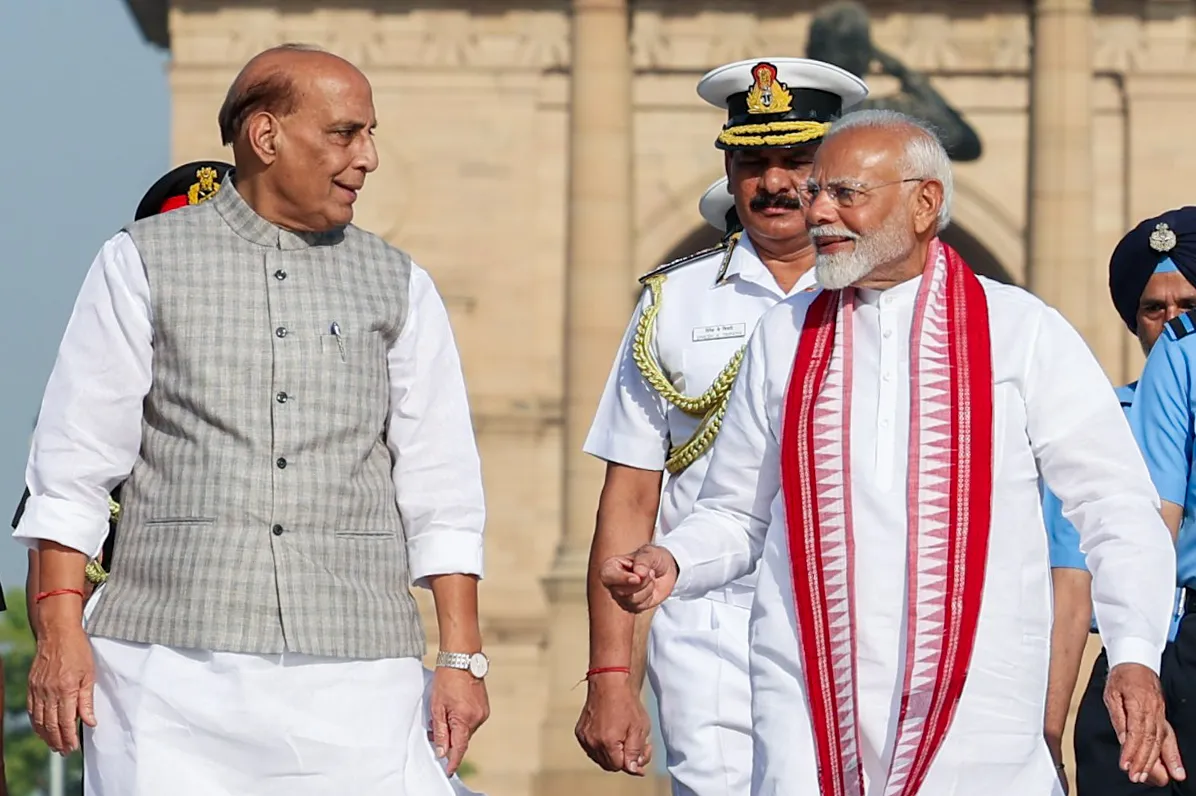
Make in India: Defence Minister Rajnath Singh signed deal for BrahMos
India’s diplomatic engagements and defence strategies are guided by national interests and remain free from external influence. India is no longer just a buyer of world-class weaponry, it is also a producer.
The Ministry of Defence signed five major capital acquisition contracts worth Rs 39,125.39 crore on March 1, 2024 in New Delhi. The Contracts were exchanged in the presence of Defence Minister Rajnath Singh and Defence Secretary Giridhar Aramane.
Out of the five contracts, one was with Hindustan Aeronautics Limited for procurement of Aero-engines for MiG-29 aircraft, two with Larsen & Toubro Limited for procurement of Close-in Weapon System and procurement of High-Power Radar and two with BrahMos Aerospace Private Limited (BAPL) for procurement of BrahMos missiles and procurement of Ship borne BrahMos system for the Indian Defence Forces.
The purpose of these deals is to strengthen indigenous capabilities, save foreign exchange and reduce dependency on Foreign Origin Equipment Manufactures in future.
The contract for procurement of BrahMos missiles has been signed with BrahMos Aerospace Private Limited (BAPL) at a cost of Rs 19,518.65 crore. These missiles would be utilised to meet combat outfit and training requirements of Indian Navy.
The contract for Procurement of Ship borne BrahMos system has also been signed with BrahMos Aerospace Private Limited (BAPL) at a cost of Rs 988.07 crore. This system is the Indian Navy’s primary weapon for maritime strike operations fitted onboard various frontline warships. The system is capable of hitting land or sea targets from extended ranges with pinpoint accuracy at supersonic speeds.
BrahMos surpasses China’s advanced air defence systems
Defence expert Sanjeev Srivastava has highlighted the unmatched power of India’s BrahMos supersonic cruise missile, citing US defence expert John Spencer’s remarks that the missile’s capabilities surpass even China’s advanced air defence systems.
“US defence expert John Spencer stated that India’s BrahMos supersonic missile is so advanced that even China’s air defence systems have been unable to intercept it. He noted that this highlights India’s significant military edge, particularly in its operations against Pakistan, where the failure of Pakistan’s HQ-9B air defence system was exposed. Spencer added that India’s successful retaliatory strikes using BrahMos missiles demonstrated their effectiveness, generating global interest in the weapon. The India-Russia collaboration on the BrahMos missile has proven to be a major success, with the system now being exported to other countries as well,” he said.
BrahMos used in Operation Sindoor confirmed UP CM Yogi Adityanath
Uttar Pradesh Chief Minister Yogi Adityanath recently confirmed that the BrahMos missiles were used during India’s military operations to strike Pakistani terror-outfits during Operation Sindoor.
“You must have seen a glimpse of the BrahMos missile during Operation Sindoor. If you didn’t, then just ask the people of Pakistan about the power of the BrahMos missile,” Adityanath said during an address to the state. He was speaking at the inauguration of the BrahMos Aerospace Integration and Testing Facility in Lucknow.
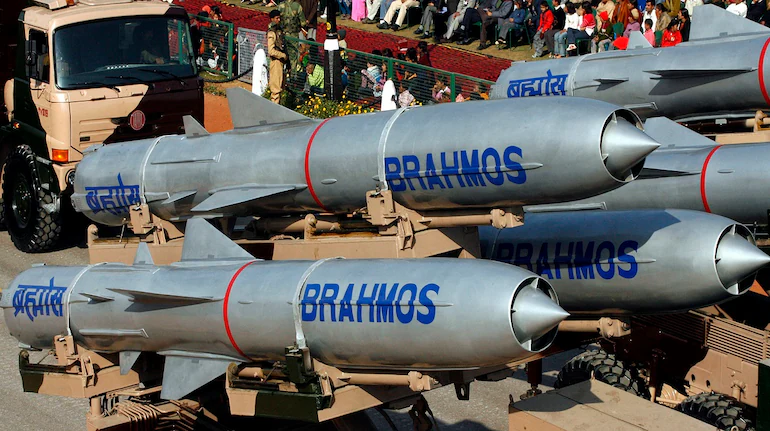
80 to 100 BrahMos missiles to be manufactured annually in Lucknow, Uttar Pradesh
Defence Minister Rajnath Singh virtually inaugurated the BrahMos supersonic cruise missile production unit at the Uttar Pradesh Defence Industrial Corridor in Lucknow last week, when India was going through escalating military tensions with Pakistan. The facility is designed to manufacture 80 to 100 missiles annually.
Built at a cost of Rs 300 crore, the production unit will produce the BrahMos missiles, which has a range of 290 to 400 km and a top speed of Mach 2.8. Developed by BrahMos Aerospace, a joint venture between India and Russia, the missile can be launched from land, sea, or air and follows a “fire and forget” guidance system.
From the newly launched Aerospace Integration and Testing Facility in Lucknow, 80 to 100 BrahMos missiles will be produced annually. In addition, 100 to 150 next-generation BrahMos missiles will also be manufactured each year. The next-generation missiles will be ready and delivered within one year.
Why India needs Russia’s approval to sell BrahMos to any other country?
During Operation Sindoor, BrahMos showed the world that India is a now a force to reckon with. And the world noticed. Countries across Southeast Asia, the Middle East and South America began approaching India expressing their interest for BrahMos. Philippines became the first official buyer in 2022, soon followed by Vietnam, Indonesia, Egypt, the UAE, Saudi Arabia and Brazil – all of them eager to acquire the missile that shattered Pakistan’s air defence.
However, there is a problem. India cannot sell BrahMos freely as the missile is not completely Indian in origin. BrahMos is the result of a joint venture between India’s Defence Research and Development Organisation (DRDO) and Russia’s NPO Mashinostroyeniya. The BrahMos Aerospace oversees the missile’s production, but every sale to a third country requires approval from Moscow. Both India and Russia have a 50-50 stake in the missile’s technology. And therefore, India cannot export it without Russia’s formal consent. Not only does India need Russian approval, it also has to limit the missile’s capabilities for international buyers.
अब Dr AI करेंगे ईलाज, सऊदी अरब में खुला दुनिया का पहला AI क्लिनिक
Dr AI: क्या आपने कभी सोचा था कि एक दिन मशीनें इंसानी डॉक्टरों की जगह ले लेंगी? यह कोई साइंस-फिक्शन फिल्म नहीं, बल्कि हकीकत है! सऊदी अरब ने दुनिया का पहला ऐसा क्लिनिक खोल दिया है, जहां मरीजों का निदान और इलाज आर्टिफिशियल इंटेलिजेंस (AI) के जरिए हो रहा है। चीन की मेडिकल टेक्नोलॉजी कंपनी Synyi AI ने सऊदी अरब की Almoosa Health Group के साथ मिलकर यह क्रांतिकारी कदम उठाया है। यह पायलट प्रोग्राम पिछले महीने सऊदी अरब के पूर्वी प्रांत अल-अह्सा में शुरू हुआ, और यह खबर हर जगह सुर्खियां बटोर रही है। भविष्य की चिकित्सा व्यवस्था एक नए दौर में पहुंच गई है। क्या अब डॉक्टरों की जरूरत खत्म हो जाएगी? और क्या AI डॉक्टर इंसानों से बेहतर इलाज कर सकता है?
सऊदी अरब में खुला Dr AI क्लिनिक
सऊदी अरब का यह AI क्लिनिक दुनिया में अपनी तरह का पहला प्रयोग है, जहां मरीजों का पहला संपर्क इंसानी डॉक्टर के बजाय एक AI डॉक्टर से होता है। इस नए Dr का नाम है Dr. Hua, जो एक आर्टिफिशियल इंटेलिजेंस सिस्टम है। लेकिन घबराइए मत, इंसानी डॉक्टर अभी पूरी तरह से बाहर नहीं हुए हैं! वे इस सिस्टम में सुरक्षा गार्ड की तरह काम करते हैं, जो AI के डायग्नोस और इलाज की समीक्षा करते हैं। यानि Dr Hua को फिलहाल एक इंसानी डॉक्टर की निगरानी में रहना होगा। Synyi AI के बयान के मुताबिक, “यह AI क्लिनिक एक इनोवेटिव मेडिकल सर्विस सिस्टम है, जहां AI डॉक्टर स्वतंत्र रूप से मरीजों की जांच से लेकर दवा लिखने तक का पूरा काम करते हैं, जबकि इंसानी डॉक्टर डाइग्नोस और इलाज के परिणामों की समीक्षा करके सुरक्षा सुनिश्चित करते है।
त्रुटि दर 0.3 फ़ीसदी
Synyi AI का दावा है कि टेस्टिंग फेज में इस AI की त्रुटि दर मात्र 0.3 प्रतिशत रही है। यह तकनीक Tencent, Hongshan Capital, GGV Capital और सऊदी सरकार के सहयोग से विकसित की गई है। इसमें स्थानीय भाषा, चिकित्सा शब्दावली और सांस्कृतिक पहलुओं का ध्यान रखते हुए लोकलाइज्ड LLM (Large Language Models) का उपयोग किया गया है।
AI क्लिनिक कैसे काम करता है
इस क्लिनिक में मरीजों का अनुभव बिल्कुल अनोखा है। यहां कोई सफेद कोट वाला डॉक्टर आपको स्टेथोस्कोप लगाकर नहीं देखता, बल्कि आप एक टैबलेट के सामने बैठते हैं और अपनी बीमारी के लक्षण बताते हैं। सामने होता है Dr. Hua, जो एक आर्टिफ़िशियल इंटेलिजेंस डॉक्टर है। यह सिस्टम न सिर्फ आपकी बात सुनता है, बल्कि इंसानी डॉक्टर की तरह सवाल भी पूछता है। सबसे पहले मरीज टैबलेट पर अपनी शिकायतें दर्ज करता है, जैसे खांसी, सांस लेने में तकलीफ, या गले में खराश। Dr. Hua फॉलो-अप सवाल पूछता है, जैसे “क्या आपको बुखार है?” या “कितने दिनों से यह समस्या है?” मेडिकल स्टाफ की मदद से एक्स-रे, कार्डियोग्राम, या अन्य टेस्ट किए जाते हैं, जिनका विश्लेषण Dr Hua करता है। इसके बाद Dr. Hua एक इलाज का प्लान बनाता है, जिसमें दवाएं या अन्य सलाह शामिल होती हैं। इस प्लान को एक इंसानी डॉक्टर जांचता और मंजूरी देता है, बिना मरीज से मिले।
अगर कोई इमरजेंसी हो, जो AI हैंडल नहीं कर सकता, तो इंसानी डॉक्टर तुरंत हस्तक्षेप करते हैं। अभी यह क्लिनिक 30 तरह की सांस की बीमारियों (जैसे अस्थमा और गले की खराश) का इलाज कर सकता है, लेकिन Synyi AI का लक्ष्य अगले एक साल में इसे 50 बीमारियों तक विस्तार देना है, जिसमें पेट और स्किन की बीमारियां भी शामिल होंगी।
क्या है Dr Hua की खासियत
Synyi AI की तकनीक लोकलाइज्ड लार्ज लैंग्वेज मॉडल्स (LLMs) पर आधारित है, जो सऊदी अरब की स्थानीय भाषा, चिकित्सा शब्दावली, और सांस्कृतिक बारीकियों को ध्यान में रखकर तैयार किए गए हैं। यानी यह न सिर्फ तकनीकी रूप से सक्षम है, बल्कि स्थानीय मरीजों की जरूरतों को भी समझता है। कंपनी के CEO झांग शाओडियन का कहना है, “पहले AI सिर्फ डॉक्टरों की मदद करता था, लेकिन अब हम अंतिम कदम उठा रहे हैं, जहां यह सीधे मरीजों का निदान और इलाज करेगा। इसकी तकनीक की गलती की दर 0.3 फ़ीसदी से भी कम है, जो इसे इंसानी डॉक्टरों के मुकाबले बेहद विश्वसनीय बनाती है।”
AI क्लिनिक अभी फ्री में सेवाएं दे रहा है, क्योंकि यह एक ट्रायल प्रोग्राम है। इस दौरान जमा होने वाला डेटा सऊदी अरब की स्वास्थ्य प्राधिकरणों को जमा किया जाएगा, और 18 महीनों में पूरी मंजूरी मिलने की उम्मीद है।
सिंगापुर के नेशनल यूनिवर्सिटी हॉस्पिटल के सीनियर कंसल्टेंट Ngiam Kee Yuan का कहना है, “AI अभी प्राइमरी प्रैक्टिशनर के स्तर तक नहीं पहुंचा है।” लेकिन Synyi AI का मानना है कि यह बस शुरुआत है। Dr Hua फिलहाल श्वसन संबंधी हल्की बीमारियों के ईलाज तक सीमित है, लेकिन भविष्य में पेट और त्वचा रोगों में भी AI clinic के सक्रिय होने की कोशिश जारी है।
India Post GDS 3rd Merit List 2025: इंडिया पोस्ट GDS की तीसरी लिस्ट हुई जारी, जानिए कैसे देख सकते हैं आप अपना नाम
India Post GDS 3rd Merit List 2025: इंडिया पोस्ट ने 2025 के लिए ग्रामीण डाक सेवक (GDS) भर्ती की तीसरी मेरिट लिस्ट जारी कर दी है। ये लिस्ट उन अभ्यर्थियों के लिए है जो पहली और दूसरी मेरिट लिस्ट में चयनित नहीं हो पाए थे। ऐसे में अगर आपका भी नाम पहली और दूसरी मेरिट लिस्ट में नहीं था तो आप इंडिया पोस्ट जीडीएस तीसरी मेरिट लिस्ट में अपना नाम खोज सकते हैं।
मेरिट लिस्ट में कैसे चेक करें अपना नाम
सबसे पहले, indiapostgdsonline.gov.in पर जाएं।
होमपेज पर Candidate’s Corner सेक्शन में जाएं।
GDS Online Engagement Schedule-I, January-2025 में सर्किल वाइज India Post GDS 3rd Merit List 2025 of Shortlisted Candidates लिंक पर क्लिक करें
इसके बाद राज्यवार मेरिट लिस्ट देखें। अब, अपने राज्य के नाम पर क्लिक करें और संबंधित PDF डाउनलोड करें।
डाउनलोड की गई PDF में अपने रोल नंबर या नाम को Ctrl+F दबाकर सर्च करें।
यदि आपका नाम सूची में है, तो आपका चयन हो गया है।
इसके बाद आपको अगला कदम डॉक्यूमेंट वेरिफिकेशन है, जो 3 जून 2025 से पहले आपके संबंधित डिवीजनल हेड से कराना होगा।
कब आई थी पहली और दूसरी मेरिट लिस्ट?
इंडिया पोस्ट जीडीएस की पहली मेरिट लिस्ट इसी साल मार्च के महीने में जारी हुई थी। उसके एक महीने बाद ही 21 अप्रैल को GDS 2nd Merit List 2025 जारी कर दी गई थी, और अब 20 मई को तीसरी मेरिट लिस्ट जारी हो गई है। सभी कैंडिडेट इस लिस्ट में अपना नाम सर्च कर सकते हैं।
कैसे होता है चयन?
इंडिया पोस्ट की ग्रामीण डाक सेवक (GDS) भर्ती प्रक्रिया में चयन का आधार केवल 10वीं कक्षा में प्राप्त अंकों पर निर्भर करता है। इसमें न तो कोई लिखित परीक्षा होती है और न ही इंटरव्यू। सभी उम्मीदवारों के 10वीं कक्षा के अंकों के आधार पर एक मेरिट लिस्ट तैयार की जाती है, जिसमें अधिक अंकों वाले उम्मीदवारों को प्राथमिकता दी जाती है। यदि दो उम्मीदवारों के अंक समान होते हैं, तो चयन में आयु, लिंग, और आरक्षण श्रेणी जैसे कारकों को ध्यान में रखा जाता है। उम्र में बड़े उम्मीदवारों को प्राथमिकता दी जाती है, और फिर महिला उम्मीदवारों को पुरुषों पर, और अनुसूचित जाति/जनजाति के उम्मीदवारों को सामान्य श्रेणी के उम्मीदवारों पर प्राथमिकता मिलती है।
Banking on Diversity: How Women Leaders in BFSI Can Revolutionise Financial Services Sector
India’s independence was a critical turning point for women’s participation in the financial services sector. Although the first bank in the country was established in 1770 there is barely a record of women in banking or finance-related roles. These limitations were deeply rooted in societal norms that restricted women’s participation in educational and economic opportunities. After independence, however, India’s focus on equality and women’s rights created a firm foundation for women’s participation in the workforce. The nationalisation of banks in the 1960s and the economic reforms of the 1990s further advanced their economic participation. Between the 90s and now, several women have made notable strides in the industry and inspired countless others to follow suit.
This period marked the rise of women leaders in financial services. Tarjani Vakil, was the first woman to serve as the chairperson and managing director of Exim Bank; Naina Lal Kidwai, the first woman to lead a foreign bank (HSBC) in India; and Arundhati Bhattacharya the first woman chair and MD of State Bank of India. They marked the rising importance of women in a historically male-dominated field. Today, women comprise about 24% of the Banking, Financial Services and Insurance (BFSI) workforce. But, only 15% are in leadership roles. With their growing contributions to financial innovation, and revenue generation, sector has a clear opportunity to tap into this underutilised leadership potential.
Risks, Revenues and Returns: How Women Contribute
Research consistently demonstrates the unique value women bring as leaders in finance sector. A study by S&P Global estimated that companies with women Chief Financial Officers (CFOs) achieved 6% higher profits and 8% higher stock returns. Studies have shown that having women in leadership roles can significantly benefit the banking, financial services, and insurance (BFSI) sector. An econometric analysis by the International Monetary Fund (IMF) in 2017 found that banks with women leaders or a higher percentage of women on their boards tend to be more stable and have lower non-performing loan ratios.
Women excel at creating collaborative work environments that foster innovation and inclusivity. Their approach often shows high emotional intelligence, which makes for better and more collaborative teams, and effective strategies. This characteristic proves particularly valuable in the BFSI sector, where nurturing talent and addressing customer needs are equally important.
For example, Shanti Ekambaram, the Whole Time Director at Kotak Mahindra Bank, led initiatives like the digital savings account 811 – a consumer-centric response to policy changes in India, strengthened the bank’s custody business, executed the ING Vysya merger, and raised the gender diversity ratio from 10% to 28%. Her leadership has consistently demonstrated how inclusion, fostering talent and business growth can go together.
Championing Inclusive Products & Services
Women are increasingly taking charge of their finances. Between 2015 and 2021, women operating bank accounts surged from 53% to 79%. However, their access to credit remains low – a gap that financial institutions need to address. Furthermore, the financial needs of women evolve significantly throughout their lifetime, from early career savings to investment planning and retirement security. A recent DBS study focusing on earning women in metropolitan cities highlighted the growing demand for tailored financial products that address specific needs. Without women on the supply side of financial services, these needs might not be well understood.
This is particularly the case when it comes to women-centric products and femtech. As investors, women have better insights into such products and an innate understanding of how the proposed female target audience will relate to them. According to Intellecap, approximately 70% of gender lens funds investing in women-owned businesses were either seeded by women investors or raised funds from women as limited partners.
Caspian Debt offers a great example of women’s importance as investors. Women make up 40% of the organisation’s team, with 50% of its leadership and client-facing roles held by women. This focus on gender equity has been integral to Caspian’s recognition as a 2X Flagship Fund – an initiative that sets global standards for gender lens investing by encouraging investments in women-led businesses and promoting gender balance in the workforce.
Fostering Women’s Leadership in BFSI
Networking and knowledge-sharing are crucial for advancing women’s inclusion in the BFSI sector. Building strong professional networks provides women with access to mentorship, sponsorship, and career opportunities. Platforms such as Aspire for Her and Stree-Leads help women exchange knowledge, ideas and advice on navigating challenges. Organisations, especially educational institutions, can encourage women to join such networks and leverage the insights of successful women leaders.
As with other sectors, sponsorship can be significant in advancing women in financial services too. Men in senior positions, especially in roles such as investing where women’s participation is comparatively lower, can intentionally mentor and sponsor women for leadership designations. This sponsorship, combined with flexible workplace policies and reasonable accommodation, creates an environment where women can thrive and advance their careers without compromising work-life balance.
Furthermore, it is also important to establish women as thought leaders. Encouraging them to widely share their experiences and insights can inspire the next generation of female financial leaders. Sharing their expertise and input on the more technical aspects of the financial sector is also critical in breaking biases.
The Path Forward
Increasing women’s leadership representation in the BFSI sector drives business excellence and innovation. Women leaders bring unique perspectives that enhance decision-making, improve risk management, and create more inclusive financial products. As financial services continue to evolve, the participation of women leaders will be crucial in shaping the future of the sector, the nation, and women across social strata.
Views of the author are personal and do not necessarily represent the website’s views.
 Author of the article Manoj Kumar is the Chief Human Resources Officer at Edelweiss Asset Management. He is an alumnus of the Tata Institute of Social Sciences (TISS). With certifications in GLA 360, Thomas PPA, and Predictive Index, he brings a data-driven and people-first approach to talent management and organizational development. His leadership has been recognized through the prestigious Young Millennial HR Leader accolade by the Great Manager Awards.
Author of the article Manoj Kumar is the Chief Human Resources Officer at Edelweiss Asset Management. He is an alumnus of the Tata Institute of Social Sciences (TISS). With certifications in GLA 360, Thomas PPA, and Predictive Index, he brings a data-driven and people-first approach to talent management and organizational development. His leadership has been recognized through the prestigious Young Millennial HR Leader accolade by the Great Manager Awards.

Author of the article Naghma Mulla is the CEO of EdelGive Foundation. Naghma is also a member of the Core Committee of the India Climate Collaborative – a collaboration of India’s leading philanthropies committed to addressing the climate crisis in India. Naghma is mentor at the Nadathur S. Raghavan Centre for Entrepreneurial Learning at IIM Bangalore, providing strategic support to several start-ups. She is a Chartered Accountant from the Institute of Chartered Accountants of India (ICAI) and has a Master of Commerce (M. Com.) degree from Pune University.




